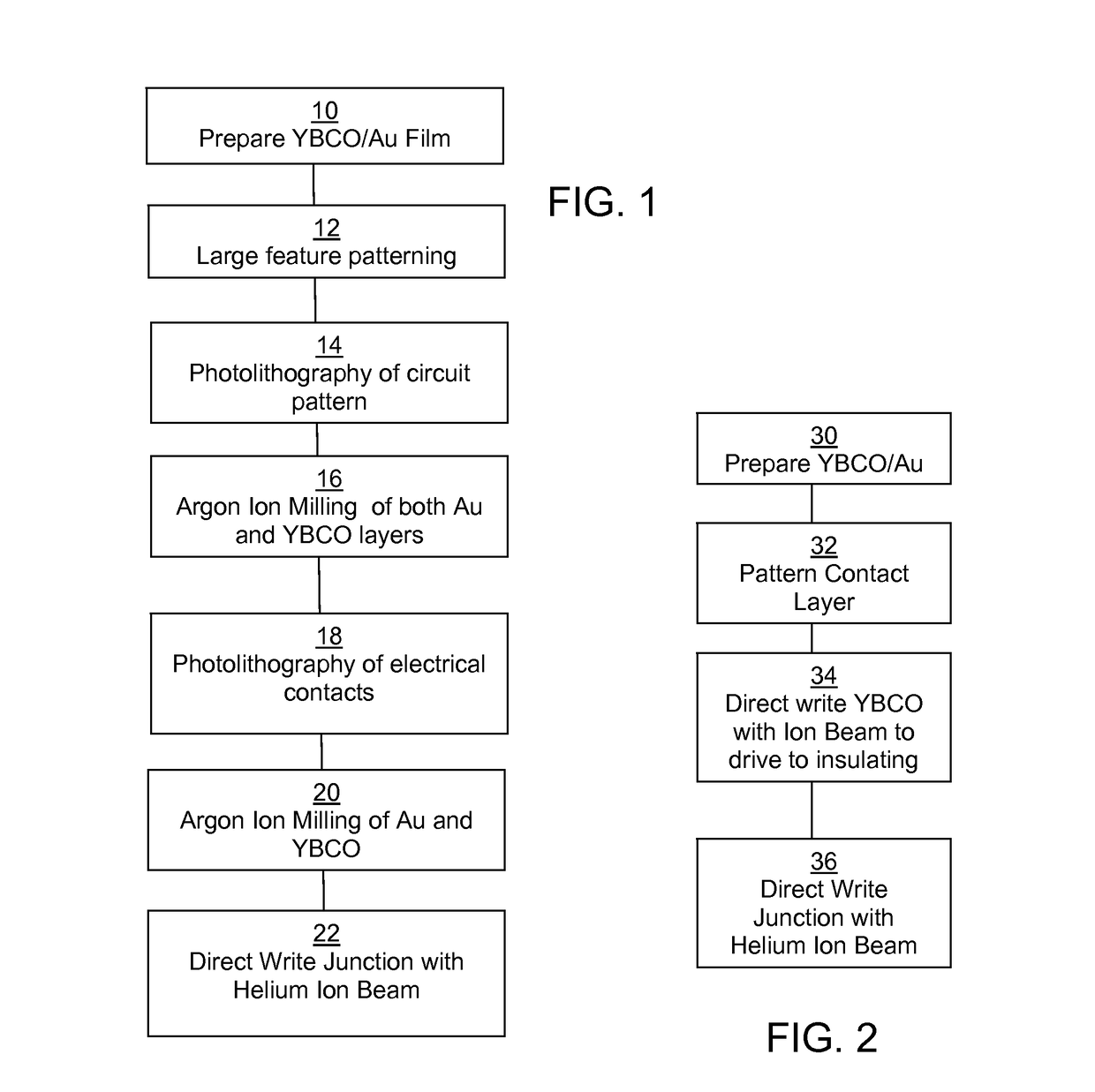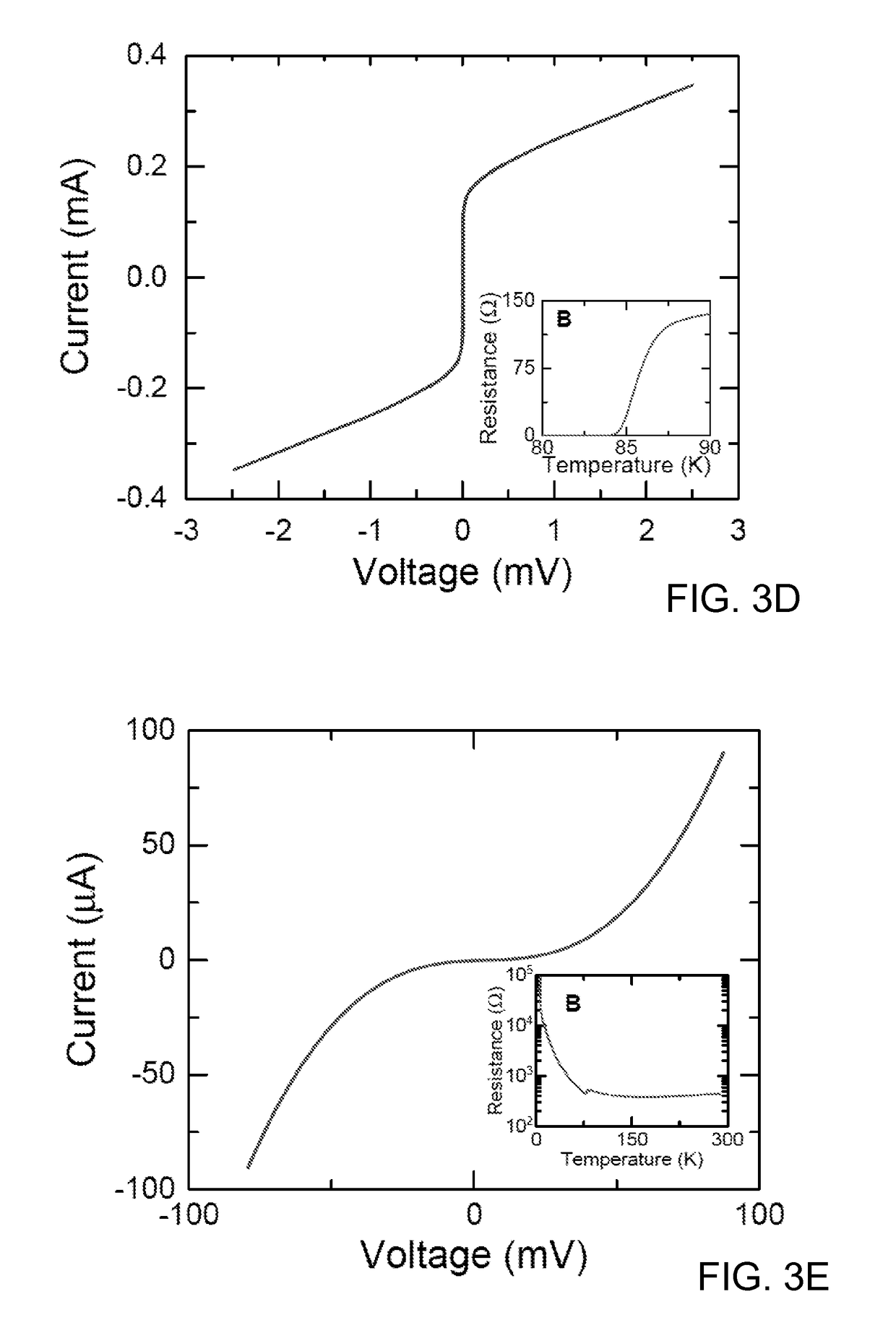Method for fabricating superconducting devices using a focused ion beam
a superconducting device and focused ion beam technology, applied in the direction of superconducting device magnitude/direction, magnetic field measurement using superconducting device, semiconductor device, etc., can solve the problems of difficult processing of hts materials, disrupting superconductivity, electrical properties of josephson junction sensitive to chemical changes and structural defects, etc., to achieve the effect of increasing the ion fluen
- Summary
- Abstract
- Description
- Claims
- Application Information
AI Technical Summary
Benefits of technology
Problems solved by technology
Method used
Image
Examples
example 1
NS Junction
[0060]The current voltage characteristics (I-V) are shown in FIG. 6A for a typical SNS Josephson junction measured for several temperatures. They were fit with integral form of the Ambegaokar-Halperin (A-H) model (V. Ambegaokar, B. I. Halperin, Phys. Rev. Lett. 23, 274 (1969)), and with the addition of added excess current determined by suppressing the Josephson current with magnetic field (FIG. 6B). From the fits, one can determine IC, RN, and the noise temperature TN. Including Iχ in these fits is essential to obtain realistic values of ICRN, which are almost always incorrectly overestimated in analysis of YBCO junctions because of the inclusion of excess current in the estimate of IC.
[0061]FIG. 6C shows the fitted IC and RN values as functions of temperature. The noise temperature of the measurement system was found to be 130 K. The decrease in resistance as temperature is lowered indicates the barrier is a conductor. The resistance ˜1Ω is roughly 10× larger than typic...
example 3
Uniformity—SNS Array
[0066]To further test the uniformity the helium ion beam junctions, arrays of closely spaced junctions connected in series were constructed by scribing multiple lines across the bridge. FIG. 9A shows I-V for several temperatures of a 20 junction SNS series array with inter junction spacing of 500 nm. The arrays exhibit much less rounding near the critical current than previously reported Josephson arrays suggesting very good uniformity of ICRN.
[0067]This high level of uniformity is also apparent when characterizing the array using the AC Josephson effect. FIG. 9B shows a 20 junction array irradiated with RF from an open circuited coax cable at 17.6 GHz. A large pronounced flat giant Shapiro step is observed at
[0068]20×hf2e=0.727mV,
suggesting that the fundamental voltage step for each junction within the array is occurring at the same bias current. This situation will only occur if the resistances are nearly the same. A series array of 20 SIS junctions was also...
example 4
Uniformity—SIS SQUID Array
[0069]An array of SIS junction SQUIDs was also fabricated. Five rectangular superconducting loops each with area 12×4 μm2 connected in parallel were patterned using the same process described above except the film was slightly thicker ˜35 nm. The I-V and its derivative are shown in FIG. 10A. As with the other tunnel junction devices, the SQUID also exhibits conductance peaks at 24=32 mV. The array was biased with a static current of 120 μA and the voltage was measured as a function of magnetic field and the resulting Fraunhofer and SQUID oscillations are shown in FIG. 10B. The Fraunhofer pattern shows self-field asymmetry in magnetic field like the single junctions with larger critical currents. The SQUID pattern exhibits a periodicity of 25 μT and a modulation depth of 40 μV (FIG. 10C). Based on the ratio of the two patterns (˜50%), the inductive parameter βL=2LIC / Φ0 was estimated to be equal to 1.0. This yields a very large value for the inductance L=0.5 ...
PUM
 Login to View More
Login to View More Abstract
Description
Claims
Application Information
 Login to View More
Login to View More - R&D
- Intellectual Property
- Life Sciences
- Materials
- Tech Scout
- Unparalleled Data Quality
- Higher Quality Content
- 60% Fewer Hallucinations
Browse by: Latest US Patents, China's latest patents, Technical Efficacy Thesaurus, Application Domain, Technology Topic, Popular Technical Reports.
© 2025 PatSnap. All rights reserved.Legal|Privacy policy|Modern Slavery Act Transparency Statement|Sitemap|About US| Contact US: help@patsnap.com



